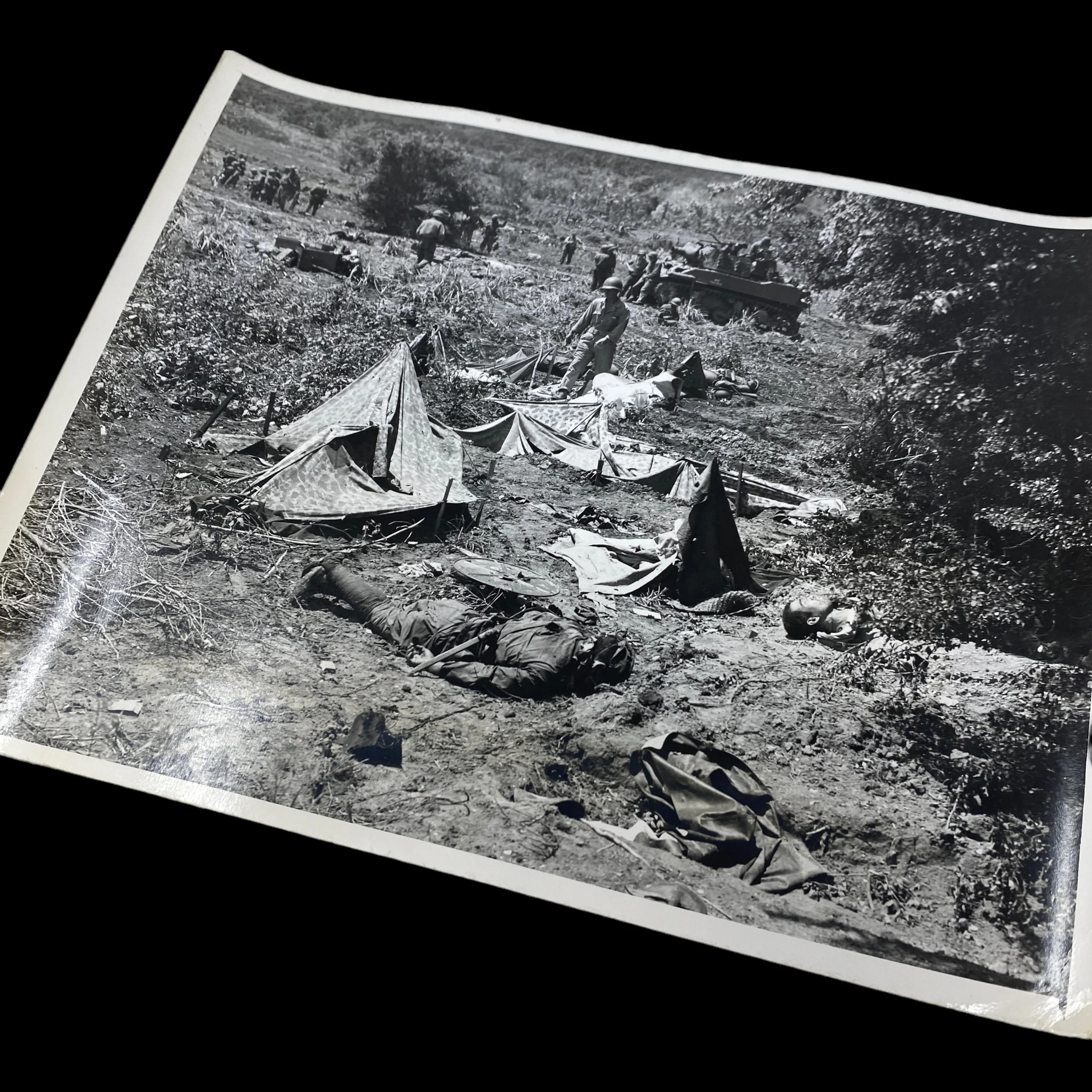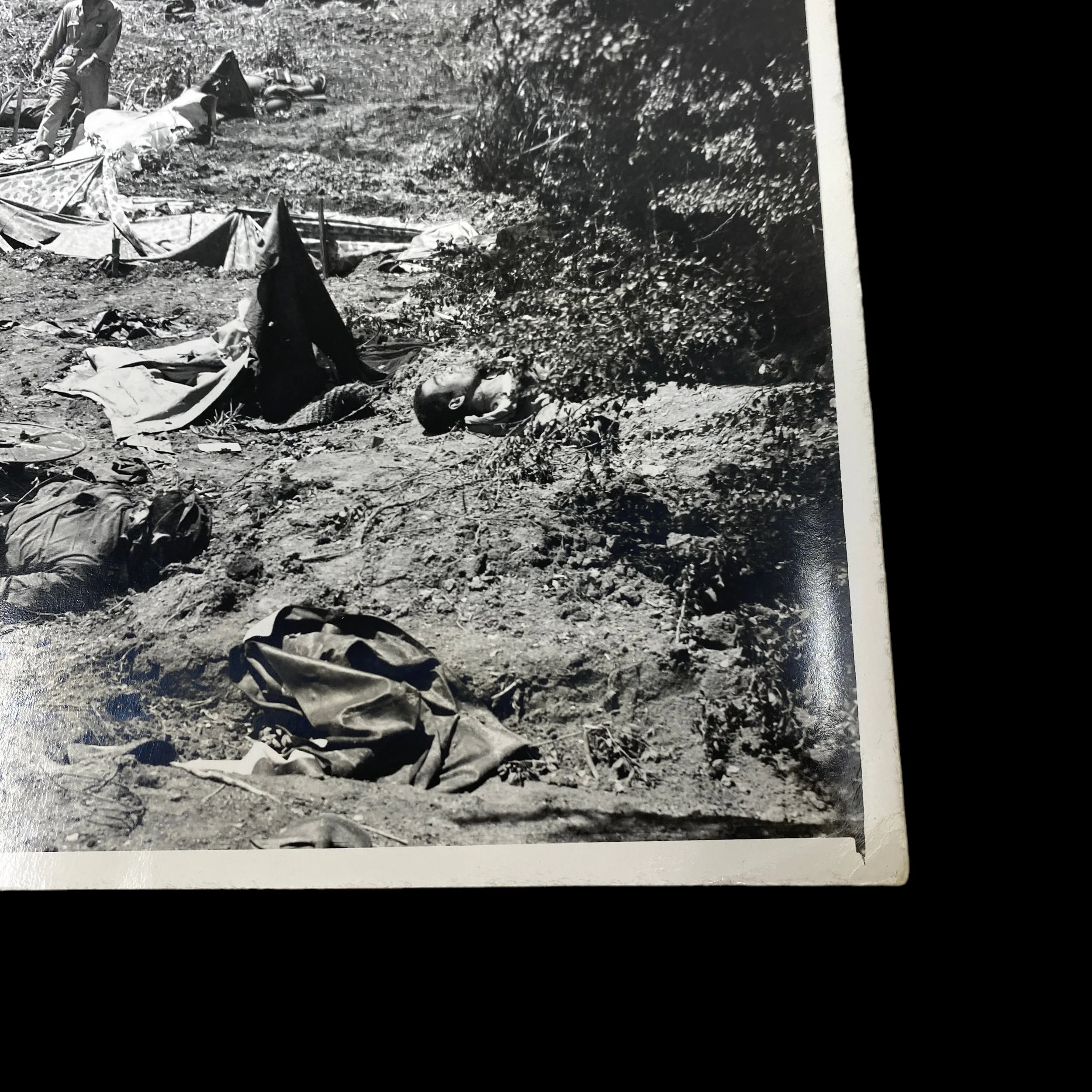VERY RARE! WWII Saipan 1st Edition UNCENSORED Pacific Theater Associated Press Combat Photograph














VERY RARE! WWII Saipan 1st Edition UNCENSORED Pacific Theater Associated Press Combat Photograph
Comes with C.O.A.
VERY RARE - 1st Edition UNCENSORED Pacific Theater combat photograph.
Japanese attack on Saipan Island
World War II (WWII) stands as one of the most pivotal and devastating conflicts in human history. It reshaped the geopolitical landscape and altered the course of nations. One of the crucial elements in documenting and conveying the realities of this global conflict was the use of combat photography. The 1st Edition Associated Press (AP) combat photos from WWII are particularly significant, as they not only provided a firsthand visual account of the war but also played a crucial role in shaping public perception and understanding of the events unfolding on the frontlines.
The period leading up to and during WWII witnessed a transformation in the field of journalism, with advancements in technology and communication facilitating a more immediate and widespread dissemination of news. The Associated Press, established in 1846, was at the forefront of this evolution. As the war unfolded, the AP deployed photojournalists to document the events, using cutting-edge equipment for the time.
Photographs have an unparalleled ability to convey the emotional impact and stark realities of war. The 1st Edition AP combat photos during WWII served as a powerful means of communication, offering the public a visceral connection to the frontlines. These images captured the chaos, bravery, and devastation of war in a way that words alone often struggled to convey. From the beaches of Normandy to the Pacific islands, these photos transported viewers to the heart of the conflict, allowing them to witness the war's toll on both soldiers and civilians.
The 1st Edition AP combat photos from WWII were characterized by their authenticity and rawness. Unlike staged or manipulated images, these photographs provided an unfiltered glimpse into the harsh realities of warfare. The photographers faced immense risks to capture these moments, often putting themselves in harm's way to bring back images that would stand as historical documents. This commitment to truth-telling enhanced the credibility of the AP and its photojournalists, solidifying their reputation as reliable chroniclers of the war.
These combat photos played a crucial role in shaping public opinion and garnering support for the war effort. As newspapers and magazines across the world featured these images, they became a powerful tool for governments to convey the necessity of the war and the sacrifices being made. The emotional impact of seeing soldiers storming the beaches of Normandy or the stoic faces of prisoners of war resonated with the public, fostering a sense of unity and resolve.
The legacy of the 1st Edition AP combat photos from WWII extends far beyond the war itself. These images have become iconic representations of a pivotal moment in human history. They have been reproduced in countless history books, documentaries, and exhibitions, ensuring that future generations have access to a visual record of the sacrifices and heroism of those who lived through WWII. The power of these images also influenced the development of photojournalism as a respected and impactful form of storytelling.
The 1st Edition Associated Press combat photos during WWII stand as a testament to the enduring power of visual storytelling. In a time when the world was gripped by the chaos and destruction of war, these photographs provided a window into the human experience on the frontlines. They captured the essence of bravery, sacrifice, and resilience, shaping public perception and leaving an indelible mark on the historical narrative of World War II. The legacy of these images continues to remind us of the human cost of conflict and the importance of bearing witness to the events that shape our world.
The Battle of Saipan, which occurred during World War II in the Pacific, marked a crucial turning point in the conflict between the Allied forces and the Empire of Japan. Saipan, one of the Northern Mariana Islands in the western Pacific, became the stage for a fierce and strategically significant battle that unfolded from June 15 to July 9, 1944. The invasion of Saipan was a pivotal moment in the Pacific theater, with far-reaching consequences for both the military and political landscape of the region.
Saipan's strategic importance lay in its proximity to the Japanese homeland and its potential use as a base for further Allied offensives. Control of Saipan would provide the Allies with a strategic foothold from which they could launch air raids and naval operations against Japan. Additionally, the island's airfields could serve as vital bases for long-range bombers, allowing the Allies to intensify their aerial assaults on the Japanese mainland.
The invasion of Saipan was part of the larger Operation Forager, a series of amphibious assaults aimed at capturing key islands in the Pacific. Under the command of Admiral Raymond A. Spruance, the U.S. Fifth Fleet executed the assault on Saipan, with the U.S. Marine Corps and the U.S. Army divisions playing pivotal roles in the ground campaign. The Japanese, under the command of Lieutenant General Yoshitsugu Saito, were well aware of the strategic importance of Saipan and were determined to defend it at all costs.
The battle began on June 15, 1944, with a massive amphibious assault by U.S. forces. The initial landings faced stiff resistance from the well-entrenched Japanese defenders, who fought fiercely from well-prepared positions. The terrain of Saipan, characterized by rugged cliffs and dense vegetation, favored the defenders and made the progress slow and challenging for the attacking forces.
The Japanese adopted a strategy of determined resistance, utilizing a combination of well-fortified defensive positions, caves, and a network of underground tunnels. The Battle of Saipan witnessed some of the most intense and brutal fighting of the Pacific War. The Japanese defenders, aware of the strategic consequences of losing Saipan, fought with remarkable tenacity and desperation. Many civilians on the island, including Japanese settlers and indigenous Chamorro people, found themselves caught in the crossfire, further complicating the situation.
The U.S. forces faced significant challenges, including the difficulty of navigating the rugged terrain, the resilience of Japanese defenses, and the harsh tropical climate. However, the superiority of Allied naval and air power, coupled with the sheer determination of the U.S. Marines and Army soldiers, gradually tipped the balance in favor of the Allies. The U.S. Navy's control of the waters around Saipan restricted Japanese reinforcements and supplies, further weakening the Japanese defense.
As the battle unfolded, the U.S. forces gained ground at a high cost in terms of casualties. The island's principal airfields, Aslito and Marpi, were eventually captured by the Allies, providing crucial bases for American aircraft. On July 7, 1944, after weeks of intense fighting, Lieutenant General Saito, recognizing the dire situation, ordered a final banzai charge, a desperate and futile attempt to turn the tide of battle. The charge resulted in heavy losses for the Japanese, and Saipan was declared secure on July 9, 1944.
The consequences of the Battle of Saipan were profound. The loss of the island was a severe blow to Japan's strategic position in the Pacific. The Allies now had a forward base for air raids on the Japanese homeland, bringing Japan within striking distance of American bombers. The victory at Saipan also set the stage for subsequent Allied offensives, including the liberation of the Philippines and the eventual invasion of the Japanese home islands.
The Battle of Saipan had significant implications for the overall course of World War II. The capture of the island marked the beginning of the end for Japan's imperial ambitions in the Pacific. The Marianas, with Saipan at its forefront, became a critical stepping stone for the Allies as they advanced towards the Japanese archipelago. The battle highlighted the importance of air and naval power, as well as the effectiveness of joint operations between the U.S. Marine Corps and the U.S. Army.
Moreover, the Battle of Saipan had a profound impact on the civilian population of the island. Many Japanese civilians, fearing capture by the Americans, chose to end their own lives rather than surrender. This tragic aspect of the battle underscored the human cost of war and the desperation that often accompanied the final stages of conflict.
In conclusion, the Japanese attack on Saipan Island during World War II was a pivotal moment that shaped the trajectory of the Pacific theater. The battle demonstrated the ferocity of the conflict in the Pacific, the challenges faced by both sides, and the strategic importance of key islands in the region. The Allied victory at Saipan marked a crucial step towards the ultimate defeat of the Japanese Empire and the eventual conclusion of World War II. The legacy of the Battle of Saipan lives on as a testament to the courage and sacrifice of those who fought on both sides and the high human cost of war in the pursuit of strategic objectives.